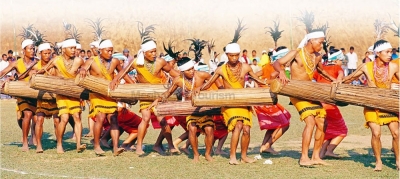|
|

|
|

|
|||
|
Wangala / Hundred Drums Festival A very important festival of the Garos is the Wangala- a harvest festival held in honour of Saljong, the Sun-god of fertility, also known as the Great Giver; and paddy goddess Minima Kiri Rokkime or Rokkime, usually held during October- November.  This Thanksgiving festival marks the end of a period of toil, which brings good yield of the fields. It is the time to relax and for days the hills and valleys resound with the distinctive beat of drums. The dance itself has certain subtle variations, the main motif being a queue of two parallel lines- one of men and other of women, clad in their festive regalia. Young and and old join the festivities with equal gaiety. While the men beat drums, the line moves forward in rhythmic unison. The 'orchestra' of men consists of drums, gong and flutes punctuated by the sonorous music of an indigenous flute made of buffalo horn. There is a noticeable sense of rhythm in the participants, young and old, and the vigorous dance leaves a lasting impression upon the beholder. Traditionally, young boys and girls choose their life partners during this festival. With the advance of modern civilization, Wangala, the cultural identity of the Garos was seen to be slowly disappearing. The Wangala is still practiced by a few traditional beleivers in some non-christian villages, but much of the Garo hills is christianized. Hence in order to preserve, protect and promote the cultural identity of the Garos, a group of intellectual leaders got together to form the Hundred Drums Wangala Festival Committee and decided to organize the Wangala Festival on modern lines. The 'Hundred Drums Wangala Festival' of the tribal Garos
is held every year in the second week of November, in Meghalaya's West Garo
Hills district. The fest begins with the arrival of the ten dancing troupes
from various parts of Garo Hills. A dancing troupe of 30 persons with ten
drums forms a contingent and 10 such contingents with 300 dancers make up
the Hundred Drums Wangala Festival. The festival first started in the year
1976 at Asanang village, the headquarters of Rongram Community and Rural
Development block and since then it is being held every year. As part of the
three-day traditional festivities, indigenous games and sports;
indigenous-based vocal and instrumental competitions; handloom and
handicraft exhibition; Rugala ceremony on the
second day, and Sa sat so a/ Dani Doka ceremony, and Wangala dance
competition among the 10 Wangala dance contingents are held. On the third or
final day, the festival closes with the grand Hundred Drums Wangala dance. Festival Calendar of Meghalaya. |
|||